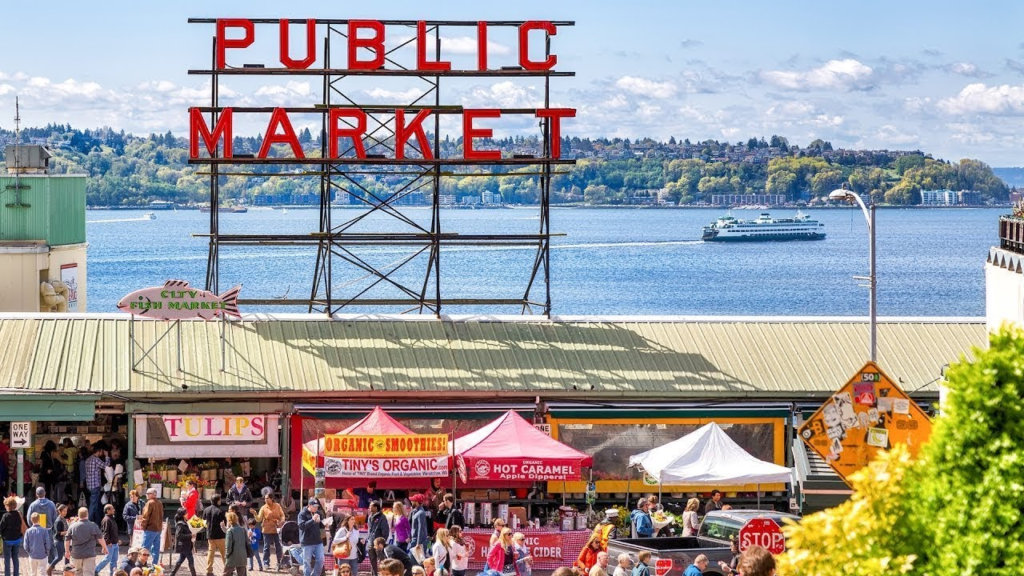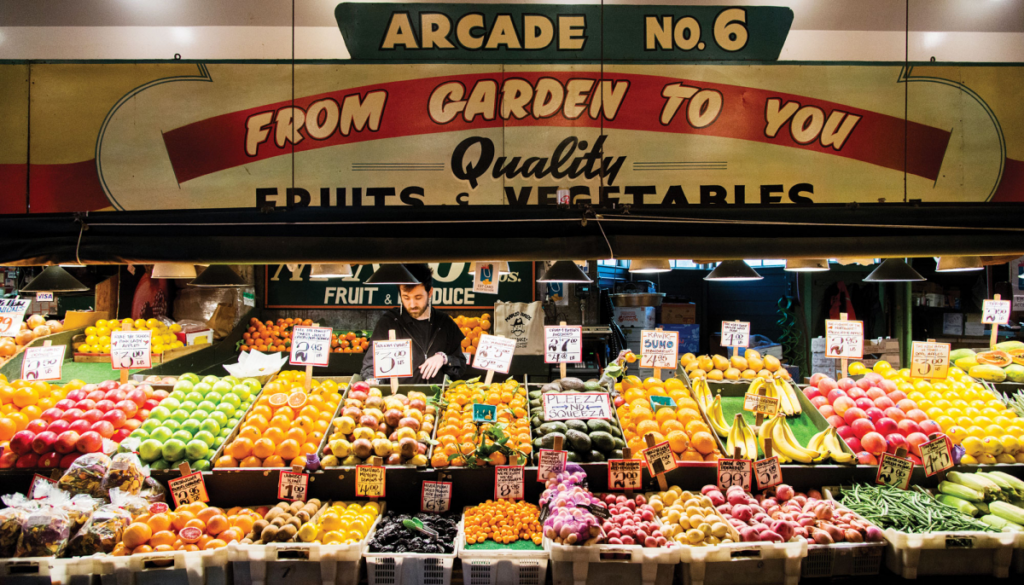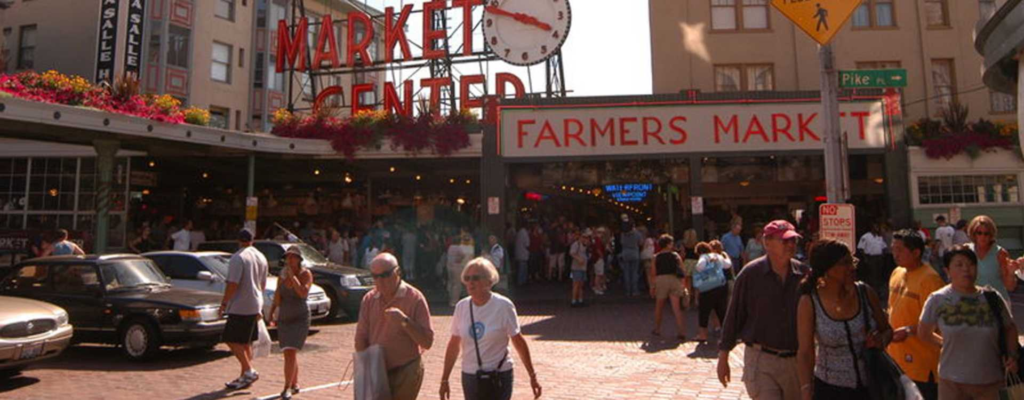With a bevy of noises, smells, personalities, jokes and urban theater scattered freely around a spatially challenging waterfront, Pike Place Market is Seattle in a bottle. Operating since 1907 and still as vibrant today as it was on the first day, this great local experience showcases the true face of the city.
All-inclusive, versatile, and proudly unique.
Expanding market infrastructure in 2017 added retail space, weather-protected common areas, additional parking, and low-income senior housing.
If you’re coming from downtown, walk down Pike Street toward the waterfront. You can’t miss the huge Public Market sign on the horizon. By the way, the sign and clock, installed in 1927, was one of the first outdoor neon installations on the West Coast. Stop at the top of Pike Street and First Avenue to witness the hustle and bustle. Walk the cobbled streets, past the perpetually stranded cars (don’t even think about getting off at Pike Place), stop before entering the market and shake the bronze nose of the market pig Rachel. market.

Sculpted by Whidbey Island artist Georgia Gerber and named after a real pig, this life-size piggy bank brings in about $10,000 each year. Funds are sent back to market social services. There is an information booth nearby that sells market maps and information about Seattle. It also doubles as a ticket office, selling discounted tickets for various shows around the city.
History of Pike Place Market
Pike Place Market is the oldest continuously operating market in the country. It was founded in 1907 to provide local farmers with a place to sell their fruits and vegetables, eliminating middlemen. Greengrocers were soon replaced by fishmongers, bakers, butchers, cheese vendors, grocers selling imported goods, and other Northwest agricultural purveyors.
Architecturally, this market has not always been robust. There was always a jumble of sheds and stalls haphazardly designed for convenience and never intended as a tourist attraction. It came later. An enthusiastic farming community created a market heyday in the 1930s. Many of the first farmers were immigrants. In fact, the market celebrates with an annual theme that recognizes the contributions of various ethnic groups. Over the past few years, it has been represented by Japanese Americans, Italian Americans, and Sephardic Jewish Americans.

In the 1960s, market sales were plagued by suburbanization, supermarket growth, and displacement from small local nurseries. Vast tracts of farmland have disappeared, replaced by ventures like Northgate Mall and Sea-Tac Airport.
The internment of Japanese American farmers during World War II also took its toll. The entire area became a haven for the poor and was known as a center of disrepute.
After the 1962 World’s Fair, plans were made to build high-rise office and apartment buildings in this prime downtown location, surrounding the market. Fortunately, public outcry sparked voter initiatives to save the market. The space has since been wiped down, rebuilt, and once again the unmistakable heartbeat of downtown. Around 10 million people stroll through the market each year.
Thanks to the market’s own management, social services programs and low-income housing, commerce is mixed with the market and the market remains doomed. These initiatives prevent the area from becoming too upscale.

The Market Law prohibits chain stores and franchises from setting up shop and ensures that all businesses are locally owned. One exception, of course, is Starbucks. Starbucks avoids the market location as it is the coffee giant’s oldest location, having moved here from its original location in 1976.
2015 saw the groundbreaking ceremony for the Pike Up Project, a 30,000-square-foot extension of Pike Place. Enabled by the demolition of the Alaskan Way viaduct, the MarketFront complex opened in 2017 with new shops, restaurants and stalls, connecting the market to the waterfront via terraces, stairs and green space.
Main and North Arcades
Rachel the Market Pig marks the main entrance to the main and north arcades, thin scaly structures that run along the edge of the hill. These are the busiest market buildings.

With fresh produce artfully displayed and fresh fish, crab and other shellfish piled on ice, this is the true heart of the market. Here you can see fishmongers tossing salmon like basketball (many of these vendors package their fish for next-day delivery).
You’ll also find cheese shops, butcher shops, stalls selling magazines and sweets from around the world, small stalls and everything you need to prepare your meals. The end of the North Arcade is dedicated to local artisans and artisans. Products sold here must be handmade. It is also blooming in flower shops. The Main Arcade was Frank Goodwin’s first market building built in 1907.
Down Under
As if the market’s ground level alone wasn’t enough of a labyrinth of labyrinths, below the main arcade are his three lower levels, called Down Under. There’s an amazing mix of pocket-sized stores here, from Indian spice stalls to magic supply stores to vintage magazine and map dealers.
Economy market building

South of the market entrance, the Economy Market Building was once a merchant’s stable and now houses the excellent Italian grocer DeLaurenti. It’s also home to one of the West Coast’s oldest pharmacies, Tenzing Momo, where you can buy herbal remedies, incense, oils and books. Tarot readings are available here at any time. Economy A look at his market floor shows that in the 1980s he had 46,000 tiles sold to the public for $35 each.
Once you buy a tile, put your name on it and be proud that you saved the market. Notable tile owners include Seuss, inventor of Dr. Cat in the Hut and former US President Ronald Reagan.
South arcade
Pass DeLaurenti and you’ll come to the market’s newest wing, the South Arcade. Here you’ll find upmarket shops and the lively Pike Pub & Brewery. It’s not technically part of the historic market, but it has a spirit and a raucous energy.
Corner and sanitary market building
Across from Pike Place from the main arcade is the 1912 Corner & Sanitary Market Building. The building got its name because it was the first market building to ban live animals.
It’s now a labyrinth of ethnic cuisine and great little restaurants, including the Three Girls Bakery, which is as old as the building itself, and the hugely popular Crumpet Shop. After you’ve finished your baked goods, head over to Bolichy’s Left Bank Books for a little bit of extreme fiction.
Post Alley
The narrow Alley of Posts (named after the pendant His Post) between the Corner Market and the Triangle Building is lined with shops and restaurants. Extending north across Stewart Street, he has two of the best drink spots in the area.
The Pink Door Ristorante, an Italian retreat with a cool terrace, and Kell’s, an Irish pub.

Next to the market sign on Lower Post Alley is the LaSalle Hotel, the first brothel north of Yesler Way. Originally the Outlook Hotel, it was taken over by the infamous Nellie Curtis in 1942. Nellie Curtis, a woman with 13 aliases, had a knack for running a questionably lucrative hotel with thousands of sailors queuing out her door every night. The building was renovated in 1977 and now has commercial and residential spaces. Post Alley continues on the south side of Pike Street and has a beautiful, disgusting gum wall. The once-venerable red-brick façade is covered in used chewing gum taped by bored theater-goers queuing outside the nearby ticket office in the 1990s.
Despite early attempts by the city government to sanitize the walls, they were marked with chewing gum stickers and in 1999 the walls were declared a tourist attraction. Feel free to add your own chewy morsels to the Jackson Pollock-esque display
Next, head to Alibi Room Bar and Pizza Restaurant, one of her best hideaways on the market.
Triangle building
Tucked between Pike Place, Pine Street and Post Alley, the tiny Triangle Building is lined with cheap stalls like Mee Sum Pastries (try the steamed pork buns), juice bars and Cinnamon Works. on the stand.
First avenue building
These downtown-facing buildings are mostly his 1980s additions and blend seamlessly with the old Beehive. Here you’ll find his two only lodgings in Pike Place, Pensione Nichols and Inn at the Market, as well as some community facilities, including a classy pub and a medical centre.
Northern end
The northern end of the market stretches along Pike Place from Pine Street to Victor Steinbruck Park and is a popular meeting point for daily walks. Built in 1918, the Soames-Dunn Building was once home to a seed and paper company and now houses the world’s oldest Starbucks. Watch out for crowds and stray elbows flipping mermaid logo coffee mugs.
Pike Place Market opening hours
Early risers don’t just catch worms at Pike Place Market. Main he head to the arcade and watch the fish launchers warm up before market roll he calls the real street he theater he be there at exactly 9:00. The purpose of the roll call is to allocate space to temporary craft vendors in the marketplace.
With over 200 registered vendors at Pike Place but only 130 trading locations available, every day is exciting. Until 9:00:
At 3.30pm, the seats were filled and everyone left. Roll call takes place at the north end of the north arcade.
